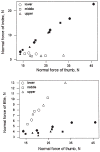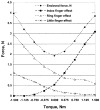Prehension synergies
- PMID: 15064652
- PMCID: PMC2821099
- DOI: 10.1097/00003677-200404000-00007
Prehension synergies
Abstract
The precision grip requires the control of the normal and tangential forces exerted by the fingers as well as the control of the rotational equilibrium of the grasped object. Prehension synergies involve the conjoint changes in finger forces and moments during multifinger gripping tasks. Some of these adjustments are dictated by mechanics, whereas others are the result of a choice by the performer.
Figures






References
-
- Arimoto S, Tahara K, Yamaguchi M, Nguyen PTA, Han HY. Principle of superposition for controlling pinch motions by means of robot fingers with soft tips. Robotica. 2001;19:21–28.
-
- Baud-Bovy G, Soechting JF. Two virtual fingers in the control of the tripod grasp. J Neurophysiol. 2001;86:604–615. - PubMed
-
- Bernstein NA. The Co-ordination and Regulation of Movement. Oxford: Pergamon Press; 1967.
-
- Cole KJ, Abbs JH. Coordination of three-joint digit movements for rapid finger-thumb grasp. J Neurophysiol. 1986;55:1407–1423. - PubMed
-
- Danion F, Schoner G, Latash ML, Li S, Scholz JP, Zatsiorsky VM. A mode hypothesis for finger interaction during multi-finger force-production tasks. Biol Cybern. 2003;88:91–98. - PubMed
Publication types
MeSH terms
Grants and funding
LinkOut - more resources
Full Text Sources
Other Literature Sources

